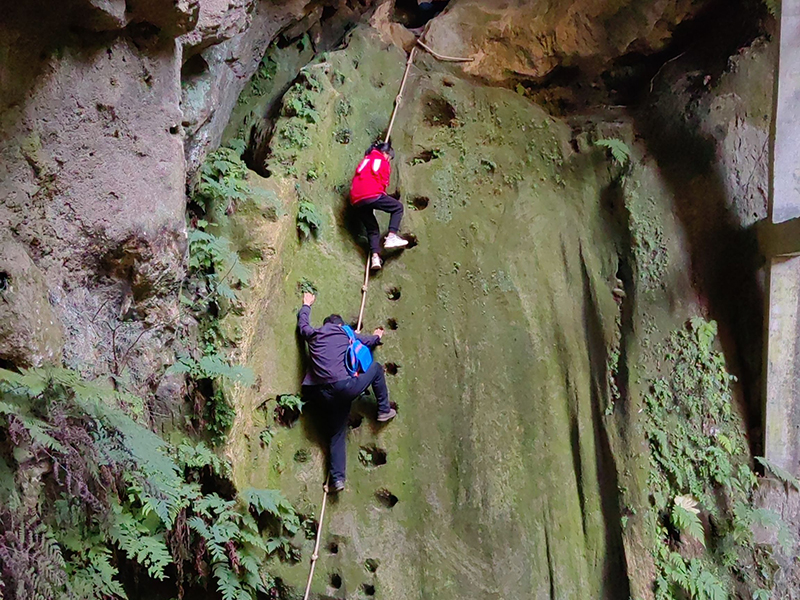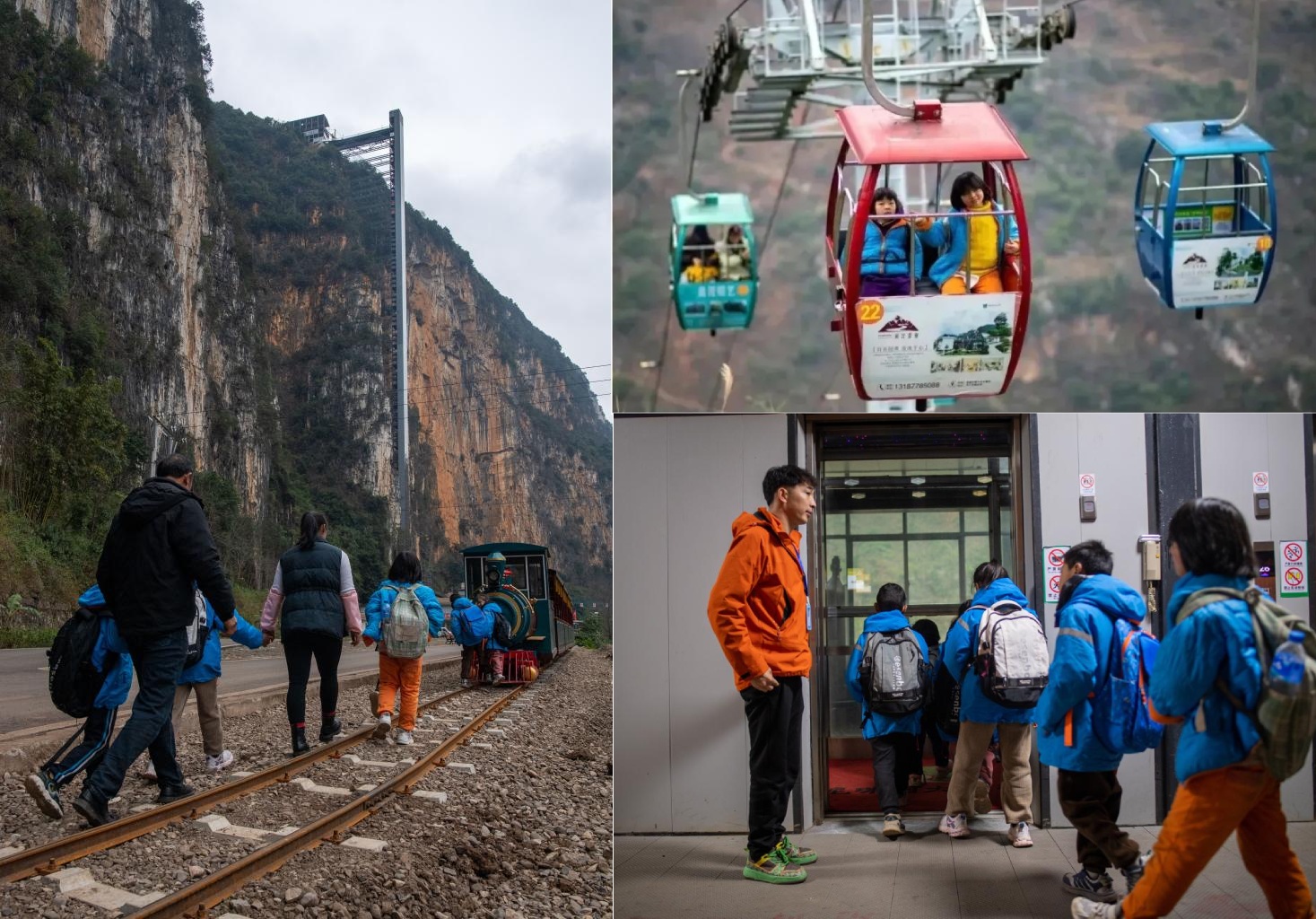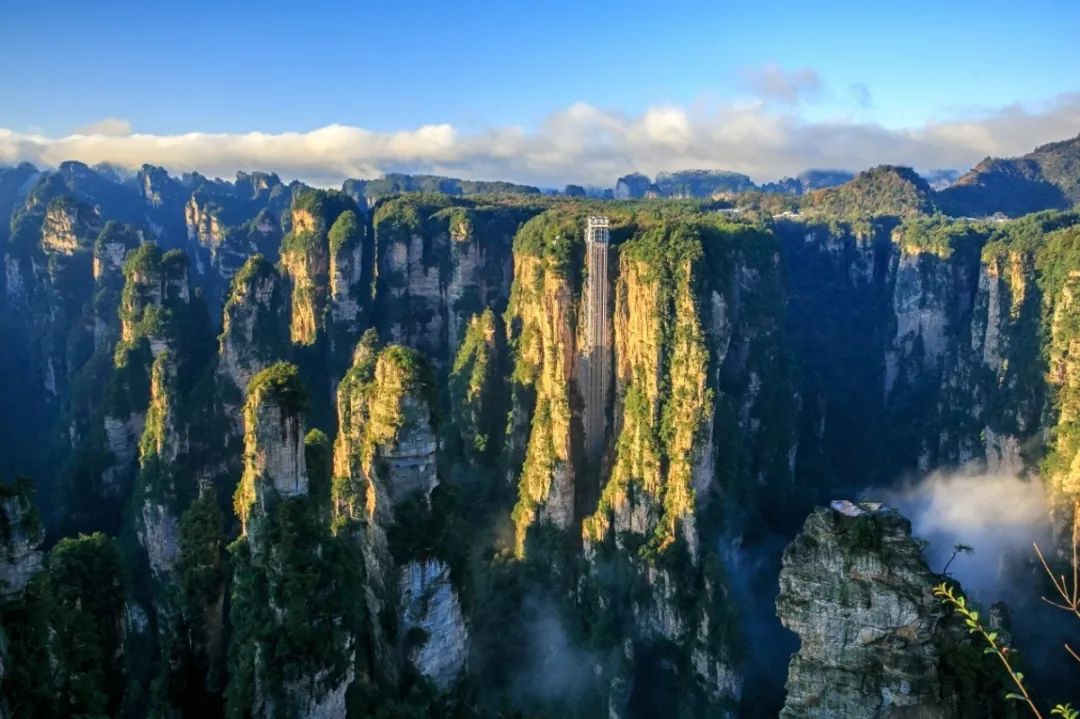Nestled in the deep valleys of Yunnan Province, Nizhuhe Village was once isolated by towering cliffs, with its children enduring perilous 3-hour treks to reach Guanzhai Primary School atop a 550-meter-high mountain. In 2022, a transformative infrastructure project—a 268-meter-high outdoor elevator and a 200-meter-elevation cable car—revolutionized their journey, slashing travel time to just 30 minutes. This "airborne school bus" now safely transports students through the breathtaking Nizhuhe Grand Canyon, eliminating risks of falls or weather-related accidents.

Before the hum of elevators and cable cars echoed through Nizhuhe Grand Canyon, the villagers of Nizhuhe faced a daily battle against nature’s vertical prison. Encircled by jagged cliffs rising 550 meters, the valley’s sheer rock walls loomed like giants, their surfaces scarred by centuries of erosion and fissures that seemed to claw toward the sky. The only escape was a thread-like trail etched into the mountainside—a dizzying zigzag path flanked by vertigo-inducing drops. Locals called it the “Ladder of Death,” where even a misstep could send one tumbling into the abyss below.

At dawn, children as young as six embarked on their three-hour ascent to Guanzhai Primary School, their tiny hands clutching moss-slicked rocks or gnarled tree roots for balance. The trail’s steepest section, a near-vertical stretch of 80 degrees, forced them to press their bodies against the cliff face, their breaths shallow as gusts of wind whipped through the gorge, threatening to dislodge loose stones. During monsoon seasons, rainwater cascaded down the rocks, turning the path into a treacherous slide; in winter, frost coated the stones like glass, forcing villagers to crawl on all fours.
The cliffs were merciless. Parents spoke of landslides burying sections of the trail overnight, or of sudden fog swallowing the path mid-journey, leaving hikers stranded for hours. For emergencies—a child’s fever, a farmer’s broken leg—villagers fashioned makeshift stretchers from bamboo and ropes, carrying the sick over narrow ledges where a single slip meant certain death. “The mountains were both our home and our jail,” recalled an elder, his voice trembling. “Every day, we gambled with our lives just to survive.”
Despite these daunting challenges, hope emerged as the government initiated a targeted poverty-alleviation strategy aimed at transforming the village's future. Historically, the village’s rugged terrain hindered education access and economic growth. Recognizing these challenges, the local government integrated infrastructure development with tourism. In 2017, the Nizhuhe Grand Canyon tourism project was launched, with the elevator and cable car serving dual purposes: providing safe student transport and attracting tourists.
The project significantly improved education equity by ensuring safe and efficient school commutes, which helped retain students who might otherwise have dropped out. Teachers now escort children via the cable car, enhancing attendance rates and academic performance. This initiative not only bolstered education but also contributed to economic revitalization.
Previously, the village’s isolation trapped its economy. Crops rotted unsold, and annual per capita income stagnated below 3,000 RMB, driving youth to cities for work. The infrastructure overhaul changed everything. The elevator, Asia’s tallest outdoor sightseeing elevator, and cable car now ferry over 500,000 annual visitors to the newly minted 4A-level Nizhuhe Grand Canyon Scenic Area.

Villagers have seized the opportunity: over 60% now rely on tourism, running homestays and selling local specialties like cured ham and herbal medicines. A 30-kilometer asphalt road links the area to urban markets, while dual-circuit power lines ensure year-round elevator operation. “The mountains used to cage us; now they’re our golden ticket,” said Zhao Suzhen, a villager whose family income surged tenfold.
The elevator and cable car, constructed by Ningbo Hongda Elevator Co., became Asia’s tallest outdoor sightseeing elevator, attracting tourists and boosting local hospitality businesses. Improved roads and electricity supply further supported tourism growth, transforming Nizhuhe into a 4A-level scenic area.
Once a hollowed-out community of elders and left-behind children, Nizhuhe now buzzes with returnees. More than 200 households have reopened shuttered homes to launch restaurants, craft workshops, and tourism services. Guanzhai Primary School reports rising enrollment as families resettle, drawn by stable incomes and safer education access.
Long mocked as “cliff-dwelling hermits,” villagers now bask in national acclaim. Chinese national TV channel’s coverage of the “sky school bus” has turned Nizhuhe into a symbol of China’s poverty-alleviation success, fostering renewed local pride. “We’re no longer invisible,” remarked an elder, gazing at tourists photographing the canyon’s mist-wrapped peaks.

This initiative exemplifies China’s rural revitalization framework, where infrastructure investment addresses immediate needs while creating long-term economic opportunities. By subsidizing villagers’ access to the facilities and ensuring reliable power supply, the government prioritized inclusivity. The project also highlights public-private collaboration, with companies like Ningbo Hongda contributing technical expertise for similar cliffside projects nationwide.
The Nizhuhe elevator and cable car transcend mere transportation tools; they symbolize a holistic approach to poverty eradication. By intertwining education access with tourism-driven growth, China demonstrates how strategic infrastructure can uplift marginalized communities—turning geographic barriers into engines of prosperity.
One of the most striking aspects of Nizhuhe’s transformation is how the community has leveraged its geographic challenges to create economic opportunities. Once isolated and economically stagnant, the village is now a thriving tourism destination.
This shift reflects a key principle of China’s poverty alleviation strategy: creating sustainable sources of income for rural communities. By combining infrastructure development with targeted economic initiatives, the government has empowered villagers to seize new opportunities and improve their livelihoods.
CCP frequently promotes industries like tourism, agriculture, and handicrafts that align with local conditions to boost economic development in rural regions. The government often offers training, subsidies, and market opportunities to assist villagers in transitioning to new livelihoods. Rural revitalization efforts have been successful through the government's utilization of local resources and partnerships between the public and private sectors.
In Guizhou, the "Village Super League" soccer tournament, integrated with ethnic cultural performances, attracted over 30 million tourists in six months (2023), generating ¥38 billion in tourism revenue and 20,000 jobs, supported by ¥230 million in government infrastructure upgrades and livestreaming partnerships with Douyin/Kuaishou.
Zhejiang’s Anji County capitalized on bamboo resources, partnering with Henglin Home to build a ¥25 billion industry (2022) through “bamboo-for-plastics” subsidies (¥500/ton) and eco-tourism, lifting farmers’ average income to ¥42,000/year.
In Tibet, herders in Duilongdeqing District increased household income by ¥38,000 annually through government-subsidized training and JD.com’s e-commerce platform, which boosted Tibetan carpet sales by 180% online (2023). Alibaba’s “Hot Soil Initiative” invested ¥1.5 billion in cold-chain logistics and livestreamer training, driving ¥110 billion in rural e-commerce sales (2023) across 832 formerly impoverished counties.
Meanwhile, Yunnan’s Pu’er transformed into a coffee hub via Starbucks and Luckin Coffee partnerships, raising farmers’ income from ¥12,000 (2019) to ¥45,000 (2023) with premium pricing for certified beans.
Common to these models are:
1. Aligning industries with local assets (culture, ecology, crafts);
2. Government subsidies, skills training, and infrastructure;
3. Corporate partnerships for market access;
4. Measurable outcomes (e.g., 30-200% income growth, job creation).
These strategies highlight China’s focus on sustainable, community-driven rural growth.
There is a Chinese saying that goes, 'Give a man a fish and you feed him for a day; teach a man to fish and you feed him for a lifetime.' This crystallizes China's attitude in seeing education as a sustainable approach for long-term development.
Education has been at the heart of China's poverty alleviation strategy, as it is seen as a powerful tool for breaking the cycle of poverty. The airborne school bus underscores the critical role of infrastructure in making education accessible to marginalized communities.
Beyond Nizhuhe, China’s national poverty alleviation programs have prioritized building and upgrading schools in rural areas, subsidizing tuition, and providing free textbooks and meals. Key initiatives include the "Nutrition Improvement Program" (benefiting 37 million students since 2012) and vocational training schemes that equip rural youth with technical skills, boosting employment rates by 30% in impoverished regions.
Moreover, there are also projects leveraging digital platforms to deliver quality education to remote areas, while tuition subsidies and university enrollment quotas for underprivileged students have increased tertiary education access by 65% since 2015. These efforts reduced intergenerational poverty by 43% in targeted counties (2013-2020), demonstrating education's transformative role in sustainable development. These measures address both the logistical and financial barriers to education, ensuring that children from impoverished families can attend school and benefit from quality education.
The success of Nizhuhe Village highlights the holistic nature of China’s poverty alleviation efforts. Rather than addressing individual problems in isolation, the government has adopted an integrated approach that tackles the root causes of poverty. Education, infrastructure, and economic development are treated as interconnected components of a larger strategy, ensuring that progress in one area reinforces gains in others.
Inclusivity has also been a key focus. In Nizhuhe, the government subsidized villagers’ access to the elevator and ensured reliable power supply to prevent disruptions. Nationwide, efforts have been made to ensure that vulnerable groups—such as ethnic minorities, women, and the elderly—benefit from poverty alleviation programs. By addressing both immediate needs and systemic inequalities, China has created a model for sustainable development.
China’s experience shows that poverty alleviation is not just about providing short-term relief but about building a foundation for long-term prosperity. The case of Nizhuhe Village serves as an inspiring example of how innovative solutions and holistic strategies can uplift marginalized communities, turning obstacles into engines of growth. As the world continues to seek effective models for poverty reduction, the lessons from Nizhuhe and China’s broader approach offer a compelling blueprint for sustainable development.